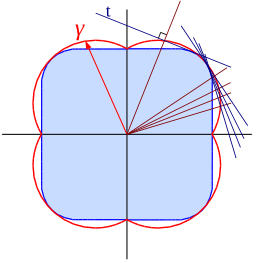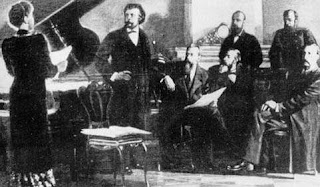| William Thomson, Baron Kelvin of Largs (1824-1907) Painted by Hubert von Herkomer |
So that I can skip on his scientific and engineering work, I'll give only a brief summary of William Thomson's life. He was born in Belfast and moved to Glasgow as a child. He studied at the Universities of Glasgow and Cambridge (where he was on the rowing team). At the young age of 22 he took a professorship at the University of Glasgow and never left, despite other offers. He gave many lectures, including a series at Johns Hopkins University. He also owned a yacht, the Lalla Rookh, built for him in the late 1860s, and several of his inventions were for improving navigation. He published more than 661 papers/communications and took out 70 patents. After his death in 1907, he was buried in Westminster Abbey next to Isaac Newton.
| The Lalla Rookh From The Life of William Thomson by Silvanus Thompson |
The purchase of the ship may also have lead to his increased interest in fluid mechanics, which occurred in 1867, and was one of the subjects he discussed with Helmholtz on their journey in 1871. But his interest in fluid mechanics had a little remembered result as well--the idea of vortex atoms. Remember, the structure of the atom was not known in the mid-19th century. A common standard for atomic weights was not determined until 1860, and Mendeleev published the first periodic table in 1869. Even then, people didn't know what made up an atom. J. J. Thomson discovered the electron in 1897, and Rutherford's famous experiment which proved the existence of an atomic nucleus was not until 1909, after Kelvin's death, so the question of the nature of the atom was wide open. William Thomson spent considerable time developing the idea of vortex atoms, based on the descriptions of fluid motion made by Helmholtz, who had expanded descriptions of fluid motion to include more irrotational motion. This theory suggested that atoms are vortexes (such as smoke rings) in the ether that makes up space. By around 1883, Thomson began to feel that his theory was not sufficient to explain matter, but he had gotten other scientists thinking about the idea and furthered the field of hydrodynamics.
There is certainly more to be said, and I had hoped to say it, but hopefully that whets your appetite and you will go looking for more information on your own. The references should be quite helpful. And perhaps I will return to Kelvin at some point to talk about absolute zero, electricity, and the age of the earth. But if I try to cover them now, this post will never be finished.
Miscellaneous Works by Thomson
- "On the Measurement of Electric Resistance", Proceedings of the Royal Society of London 11, 313-328.
- "Improvement in Reflecting-Galvanometers", patent number 209942, issue date November 12, 1878.
- "On an Absolute Thermometric Scale", Philosophical Magazine and Journal of Science, 32 (January-June 1848) 313-317. In which Thomson suggests a temperature scale in which a degree change will provide the same amount of work regardless of the starting temperature.
- Mathematical and Physical Papers (London: Clay and Sons, 1890). A compilation of his papers from 1841 to 1890.
- Treatise on Natural Philosophy (with Peter Tait) (London: Clay and Sons, 1883)
- Elements of Natural Philosophy (with Peter Tait) (1872)
- Gillian Cookson, "The Transatlantic Telegraph Cable", History Today 50, no. 3 (March, 2000) 44-51. A discussion of the difficulties and personalities involved in laying the first transatlantic cable, including both the failure in 1858 and the success in 1866.
- Robert H. Silliman, "William Thompson: Smoke Rings and Nineteenth-Century Atomism", Isis 54, no. 4 (Dec., 1963) 461-474. A detailed discussion of Kelvin's vortex theory of the atom and its place in 19th century scientific thought.
- Matthew Trainer, "The Patents of William Thomson (Lord Kelvin)", World Patent Information 26, (2004) 311-317.
- University of Glasgow Library, "William Thomson, Lord Kelvin 1824-1907", online exhibition. Includes a wonderful collection of Thomson's correspondence with other illustrious scientists, including Joule and Maxwell.
- Silvanus P. Thompson, The Life of William Thomson, Baron Kelvin of Largs (London, Macmillan, 1910). A great biography of Thomson (or I assume it to be, from having read parts of it), with many letters written by him.
- Alex D. D. Craik, "Lord Kelvin on Fluid Mechanics", European Physical Journal H 37, (2012) 75-114. This appears to go in depth into Kelvin's papers and involves lots of equations.
- Alexander Russell, "The Eighth Kelvin Lecture", Journal of the Institution of Electrical Engineers 55, no. 261 (December, 1916) 1-17.
- Hasok Chang and Sang Wook Yi, "The Absolute and Its Measurement: William Thomson on Temperature", Annals of Science 62, no. 3 (2005) 281-308.


